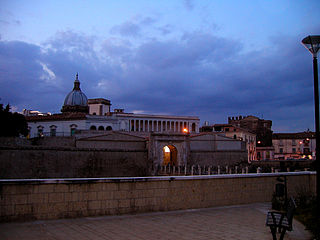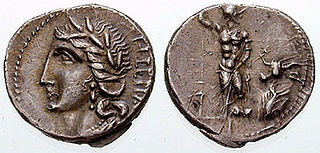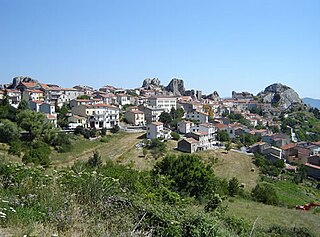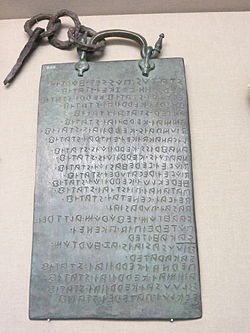
Etruscan was the language of the Etruscan civilization in the ancient region of Etruria, in Etruria Padana and Etruria Campana in what is now Italy. Etruscan influenced Latin but was eventually completely superseded by it. The Etruscans left around 13,000 inscriptions that have been found so far, only a small minority of which are of significant length; some bilingual inscriptions with texts also in Latin, Greek, or Phoenician; and a few dozen purported loanwords. Attested from 700 BC to AD 50, the relation of Etruscan to other languages has been a source of long-running speculation and study, with it mostly being referred to as one of the Tyrsenian languages, at times as an isolate and a number of other less well-known theories.

Capua is a city and comune in the province of Caserta, in the region of Campania, southern Italy, situated 25 km (16 mi) north of Naples, on the northeastern edge of the Campanian plain.

Oscan is an extinct Indo-European language of southern Italy. The language is in the Osco-Umbrian or Sabellic branch of the Italic languages. Oscan is therefore a close relative of Umbrian.

Umbrian is an extinct Italic language formerly spoken by the Umbri in the ancient Italian region of Umbria. Within the Italic languages it is closely related to the Oscan group and is therefore associated with it in the group of Osco-Umbrian languages, a term generally replaced by Sabellic in modern scholarship. Since that classification was first formulated, a number of other languages in ancient Italy were discovered to be more closely related to Umbrian. Therefore, a group, the Umbrian languages, was devised to contain them.

The Marsi were an Italic people of ancient Italy, whose chief centre was Marruvium, on the eastern shore of Lake Fucinus. The area in which they lived is now called Marsica. They originally spoke a language now termed Marsian and attested by several inscriptions.

The Pyrgi Tablets are three golden plates inscribed with a bilingual Phoenician–Etruscan dedicatory text. They are the oldest historical source documents from pre-Roman Italy and are rare examples of texts in these languages. They were discovered in 1964 during a series of excavations at the site of ancient Pyrgi, on the Tyrrhenian coast of Italy in Latium (Lazio). The text records the foundation of a temple and its dedication to the Phoenician goddess Astarte, who is identified with the Etruscan supreme goddess Uni in the Etruscan text. The temple's construction is attributed to Thefarie Velianas, ruler of the nearby city of Caere.

The Iguvine Tablets, also known as the Eugubian Tablets or Eugubine Tables, are a series of seven bronze tablets from ancient Iguvium, Italy, written in the ancient Italic language Umbrian. The earliest tablets, written in the native Umbrian alphabet, were probably produced in the 3rd century BC, and the latest, written in the Latin alphabet, from the 1st century BC. The tablets contain religious inscriptions that memorialize the acts and rites of the Atiedian Brethren, a group of 12 priests of Jupiter with important municipal functions at Iguvium. The religious structure present in the tablets resembles that of the early stage of Roman religion, reflecting the Roman archaic triad and the group of gods more strictly related to Jupiter. Discovered in a farmer's field near Scheggia in the year 1444, they are currently housed in the Civic Museum of the Palazzo dei Consoli in Gubbio.

The Tabula Capuana, is an ancient terracotta slab, 50 by 60 cm, with a long inscribed text in Etruscan, dated to about 470 BCE, apparently a ritual calendar. About 390 words are legible, making it the second-most extensive surviving Etruscan text. The longest is the linen book (Liber Linteus), also a ritual calendar, used in ancient Egypt for mummy wrappings, now at Zagreb.) It is located in the Altes Museum, Berlin.

The Cypriot or Cypriote syllabary is a syllabic script used in Iron Age Cyprus, from about the 11th to the 4th centuries BCE, when it was replaced by the Greek alphabet. A pioneer of that change was King Evagoras of Salamis. It is descended from the Cypro-Minoan syllabary, in turn, a variant or derivative of Linear A. Most texts using the script are in the Arcadocypriot dialect of Greek, but also one bilingual inscription was found in Amathus.

The Umbri were an Italic people of ancient Italy. A region called Umbria still exists and is now occupied by Italian speakers. It is somewhat smaller than the ancient Umbria.

Idalion or Idalium was an ancient city in Cyprus, in modern Dali, Nicosia District. The city was founded on the copper trade in the 3rd millennium BC. Its name in the 8th century BC was "Ed-di-al" as it appears on the Sargon Stele of 707 BC, and a little later on the Prism of Esarhaddon.

The Tabula Cortonensis is a 2200-year-old, inscribed bronze tablet in the Etruscan language, discovered in Cortona, Italy. It may record for posterity the details of an ancient legal transaction which took place in the ancient Tuscan city of Cortona, known to the Etruscans as Curtun. Its 40-line, 200-word, two-sided inscription is the third longest inscription found in the Etruscan language, and the longest discovered in the 20th century.

Agnone is a comune in the province of Isernia, in the Molise region of southern Italy, some 53 km (33 mi) northwest of Campobasso. Agnone is known for the manufacture of bells by the Marinelli Bell Foundry. The town of Agnone proper is complemented with other populated centers like Fontesambuco, Villa Canale and Rigaini.
Banzi is a town and comune in the province of Potenza, Basilicata, southern Italy.

Pietrabbondante is a comune (municipality) in the Province of Isernia in the Italian region Molise, located about 30 kilometres (19 mi) northwest of Campobasso and about 20 kilometres (12 mi) northeast of Isernia.

Veleia is an ancient town of Aemilia, Italy, about 15 km (9 mi) south of Placentia. It is mentioned by Pliny among the towns of the eighth region, though the Veleiates were ethnically Ligurians. Its inhabitants were, in the census of Vespasian, found to be remarkable for their longevity. Nothing further was known of it until 1747, when some ploughmen found the Tabula alimentaria, now in National Archaeological Museum of Parma. This, the largest inscribed bronze tablet of antiquity contains the list of estates in the territories of Veleia, Libarna, Placentia, Parma and Luca, in which Trajan had assigned before 102 CE 72,000 sesterces and then 1,044,000 sesterces on a mortgage bond to forty-six estates. The total value of which was reckoned at over 13,000,000 sesterces (~130,000), the interest on which at 5% was to serve for the support of 266 boys and 6 girls, the former receiving 16, the latter 12 sesterces a month.

The Liver of Piacenza is an Etruscan artifact found in a field on September 26, 1877, near Gossolengo, in the province of Piacenza, Italy, now kept in the Municipal Museum of Piacenza, in the Palazzo Farnese.

The family of Social War coinage includes all the coins issued by the Italic allies of the Marsic confederation, Marsi, Peligni, Piceni, Vestini, Samnites, Frentani, Marrucini, and Lucani, during the Social War against Rome.
The Tabula Bantina is a bronze tablet and one of the major sources for ancient Oscan, an extinct Indo-European language closely related to Latin. It was discovered in 1790 near Banzi, in the Italian region of Basilicata. It now may be found in the Naples Archaeological Museum.

The Temple of Jupiter Apenninus or Temple of Jupiter Poeninus was an Umbrian-Roman temple that lay at the foot of Monte Catria, near the modern village of Scheggia, between today's Umbria and Marche regions, in Italy. The temple stood near the ancient Via Flaminia, 200 km from Rome, where the road crossed the Apennines. The structure, once one of the most important Umbrian shrines, has now completely disappeared.
















